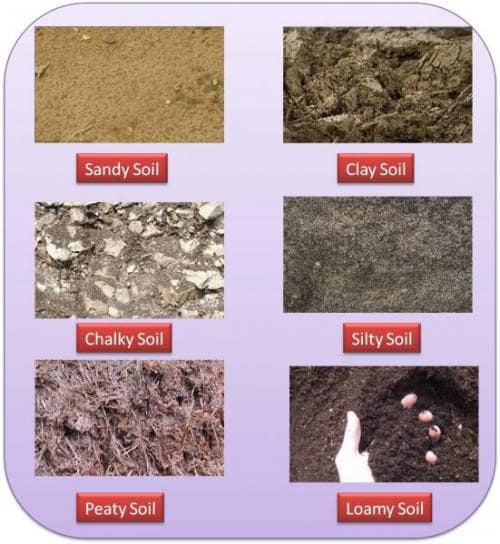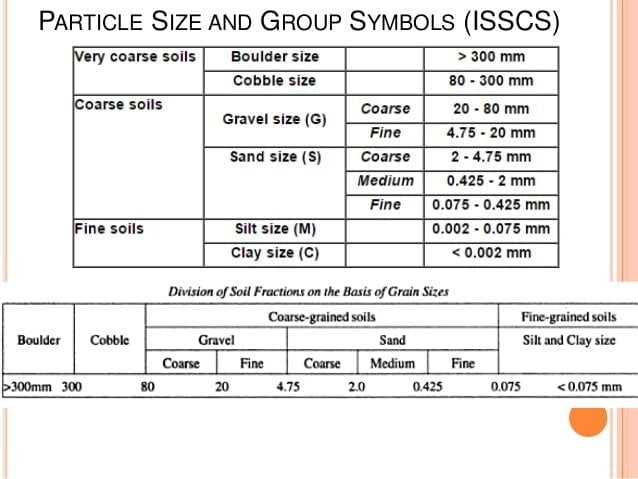Table of Contents
The soil classification system can be understood as the process of grouping the soil into various categories on a certain basis or characteristics.
The primary objective of soil classification is to divide the soil into various categories such that all the soil in a particular category has similar characteristics and nature.
It also functions as a common basis for the exchange of knowledge and experience regarding soil.
In soil classification, soil in each group is generally denoted by a particular group symbol and a general description.
The general description mostly includes the characteristic colour of the soil as well as the details regarding the chief particle of which the soil is composed.
1. General Requirements of Soil Classification System
The basic requirements of the soil classification can be listed as follows:
1. The soil classification must be based on the engineering properties of soil that are most pertinent for the purpose for which the classification has been made.
2. The classification should include only a limited number of groups.
3. The classification must be simple and readily understandable with simple terms.
2. Soil Classification Systems
The major soil classification systems have been discussed as follows:
i. Massachusetts Institute of Technology System (MIT)
The MIT soil classification system was first developed by Prof. G. Gilboy at Massachusetts Institute in the USA.
Many engineering properties of soils are related to particle size characteristics. On the basis of their particle size, soils may be classified as boulders, cobbles, gravels, sands, silts, or clays. One such method of classifying soils is MIT Soil Classification System.
In this classification, particles greater than 200 mm are considered boulders, and particles between 60 mm to 200 mm are considered cobbles.
Gravel ranges from (60mm to 2mm), Sand ranges from (2.0mm to 0.06mm) and Silt ranges from (0.06mm to 0.002mm).
Smaller than 0.002 mm is considered clayey.
In addition, each type of soil is divided into coarse, medium, and fine.
Classification of MIT Soil Classification System
According to this classification, the soil is classified into four main categories as follows:

1. Boulder ( Particle size greater than 200 mm ).
2. Cobble ( Particle size between 60 mm to 200 mm).
3. Gravel (soil with particle size greater than 2mm).
- Coarse Gravel: 20 mm to 60 mm
- Medium Gravel: 6 mm to 20 mm
- Fine Gravel: 2 mm to 6 mm
4. Sand (soil with particle size ranging from 0.06mm to 2mm).
- Coarse Sand: 0.6 mm to 2 mm
- Medium Sand: 0.2 mm to 0.6 mm
- Fine Sand: 0.06 mm to 0.2 mm
5. Silt (soil with particle size ranging from 0.002mm to 0.06mm).
- Coarse Silt: 0.02 mm to 0.06 mm
- Medium Silt: 0.006 mm to 0.02 mm
- Fine Silt: 0.002 mm to 0.006 mm
6. Clay (soil with particle size less than 0.002mm).

Figure: MIT System of Soil Classification
ii. Textural Classification of Soil
The textural soil classification system was developed by the U.S Bureau of Soils.
It is also commonly referred to as the triangular classification of soil.
The triangular chart consists of different groups of soil indicating different percentages of sand, silt, and clay-sized particles.
In this classification, first of all, the soil sample is sieved to determine the percentage of sand, silt, and clay-sized particles. Utilizing the obtained relative percentage, the triangular chart is filled.
The textural classification of soils is highly suitable for the classification of coarse-grained soils.

Figure: Textural System of Soil Classification
Three sides of above equilateral triangle represents the percentage of clay, silt and sand. Where size of:
Sand = 0.05 – 2 mm
Silt = 0.005 – 0.05mm
Clay = size < 0.005mm
Zones in Textural Soil Classification System
There are 12 zones in the triangle and each represents a different type of soil. 10 zones are:
a. Clay
b. Silty Clay
c. Sandy Clay
d. Clay Loam
e. Silty Clay Loam
f. Sandy Clay Loam
g. Loam
h. Silty Loam
i. Sandy Loam
j. Silt
k. Loamy Sand
l. Sand
Conclusion: Textural Soil Classification System
This method of classification doesn’t reveal any properties of the soil other than grain-size distribution. Hence it is suitable for the grain size distribution of coarse-grained soil only.
iii. Unified Soil Classification System
The Unified soil classification system was first introduced by Casagrande and was adopted for the first time by the Corps of Engineers of the United States of America in 1942.
A unified classification of soils is the most commonly adopted classification system of soil for engineering purposes.
It is, in fact, the universally accepted soil classification system.
In this classification system, the soil is classified based on both the plasticity characteristics and the particle size of the soil.

Each group is identified using a group symbol. The group symbol consists of primary and secondary descriptive letters.
| Primary Letters | Secondary Letters |
| G: Gravel | W: Well Graded |
| S: Sand | P: Poorly Graded |
| M: Silt | M: Non-Plastic Fines |
| C: Clay | C: Plastic Fines |
| O: Organic | L: Low Plasticity |
| Pt: Peat | H: High Plasticity |
This system classifies the soil into 15 different groups. The major divisions, however, include three categories namely coarse-grained soils, fine-grained soils, and highly organic soils.
The major divisions of the soil according to this classification have been briefly described as follows:
a. Coarse-Grained Soil
According to the Unified system of soil classification, the soil is coarse-grained if more than 50% of the soil is retained on a 0.075mm sieve.
Coarse-grained soil is further categorized into gravel (G) and sand (S).
The coarse-grained soil is gravel if more than 50% of the coarse particles are retained on the 4.75mm sieve else it is sand.
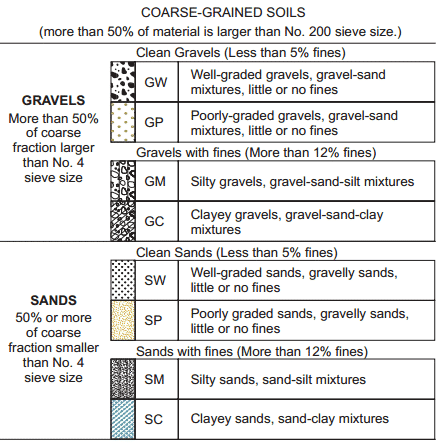
b. Fine-Grained Soil
According to the Unified system of soil classification, the soil is fine-grained if more than 50% of the soil passes through a 0.075mm sieve.
Fine-grained soil is further categorized into Low plastic (L) and High plastic (H).
This subdivision of the fine-grained is done based on the plasticity characteristics of the soil.
In case the liquid limit of the soil is less than 50, it is grouped in the soil with a low plasticity group whereas if the liquid limit of the soil is more than 50, it is grouped in the soil with a high plasticity group.
The Unified soil classification system has provided a plasticity chart based on the data on the liquid limit and the plasticity index.
A line on the chart is known as the A-line. If the data on the LL and PL plot both lies above the A-line then the soil is classified as clay.
If the data lies below the A-line then the soil is classified as either inorganic silt or organic silt which are further distinguished by oven drying. If the drying of the silt reduces the LL by 30% or even more, the soil is organic else the soil is inorganic silt.
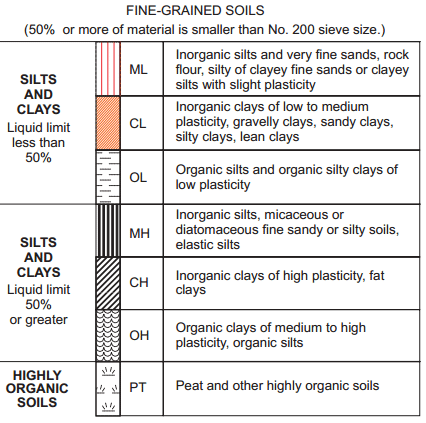
c. Highly Organic Soil
Organic soils are simply fine-grained soils essentially consisting of organic characteristics.
Some of such organic characteristics include high compressibility, dark color, strong odor, prominent visible organic materials, etc.
The organic soils are further classified as organic soil of low plasticity (symbolized as OL), organic soil of high plasticity (symbolized as OH), and Peat (symbolized as Pt).
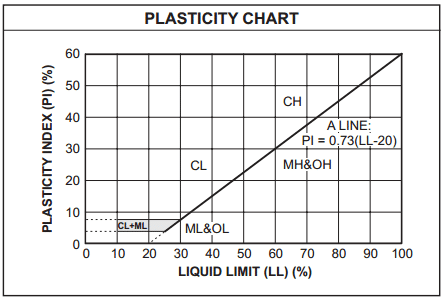
iv. Indian Standard System of Soil Classification
The Indian Standard System of soil classification was first developed by the Bureau of Indian Standards.
This system of classification is very similar to the unified soil classification system. The only difference between the two classification systems is that in the Indian standard system, the fine-grained soils are subdivided into three groups namely low, medium, and high compressibility instead of two groups of low and high compressibility as in the Unified system of soil classification.
Figure: Indian Standard System of soil classification
v. AASHTO System of Soil Classification
The AASHTO System of Soil Classification was developed by the U.S Bureau of Public Roads in 1920 for the classification of soils for highway subgrade use.
It was further revised by AASHTO in 1945.
In this system, the soil is classified depending upon the plasticity characteristics and the particle size of the soil. This system classifies the soil into seven major categories.
Figure: AASHTO System of Soil Classification
| Read More: Septic Tank |
| Read More: Prismatic Compass |

